Demystifying the Comping Process Through Entertainment Analytics
Posted: June 8, 2023 | Updated: June 12, 2023
Posted In: Articles
One powerful entertainment analytics tool that industry veterans have consistently relied on is almost as old as Hollywood itself.
The concept of “comping” or comparing your story to similar titles that align in genre, theme, storyline, budget, or even talent has historically been the most accepted way to forecast success.
Comping helps industry professionals recognize their story’s strengths and identify their script’s potential marketability. These abilities are essential to correctly positioning a story so that it reaches the right audience.

In this article, we will delve into the importance of identifying the right script comps and explore the ways in which comp selection and comparison can be used to analyze and utilize comps as a powerful tool to enhance your storytelling journey.
What Similar Stories Can Tell You About Your Own
How would you react if you were told that the highest grossing film of all time, the epic science fiction series, Avatar, was really a remake of the 1990’s western starring Kevin Costner (which also happened to win an Oscar) Dances with Wolves. No, really it’s true!
The parallels between this film and the Sci-Fi blockbuster are unquestionable, to the extent that even director James Cameron admitted Avatar was simply “Dances With Wolves in space.”
Dances with Wolves depicts the journey of a Civil War soldier after he is assigned to a remote Native American village. Upon developing a powerful relationship with the people there and falling in love with one of the women of the tribe, he begins to question his own purpose.

Dances With Wolves may not be considered a comp for the Avatar franchise in a traditional sense, but is comparable to how an audience might respond to that specific storyline, which is why thematic comparability, apart from genre, is an important consideration.

For example, if you are producing a modern heist film and only choosing heist-related movies as comps, you could be missing a much broader set of film comps.
Your comp choices would be significantly more narrow than if you positioned your film as a drama about individuals who resort to criminal solutions when they feel they have no other option, and how these events can evolve into tragic outcomes.
Finding and evaluating the right comps for your project is a lengthy process, but vital to the potential financial success and reception of your story.
Let’s explore the ways in which you identify true comps for your story and leverage the existing available information to properly execute and market your entertainment script.
Story/Narrative Genre in Entertainment Analytics
Genre is typically defined as a stylistic or thematic category that is based on similarities or narrative overlap in the defining elements, artistic approach, or emotional response to a film or series. Within each genre, there are also many sub-genres – smaller and more specific defining categories of the narrative.
For instance, if you are producing a horror film and want to select the right comps for your title, you wouldn’t just evaluate any horror film that offers some kind of resemblance to your script (and if you did, you may get a scary outcome). Rather, you’d select sub-genre elements that speak to specific aspects of the larger theme.
In the case of a horror movie, this might be slasher, supernatural, psychological, comedy or cult. These sub-genres are important to defining what kind of horror film you are producing, and signal to audiences what they can expect to see.
When StoryFit evaluates a new script, one of the first steps is running it through our AI story intelligence platform to analyze the story and generate the genre and sub-genre data elements to find the perfect comp set for the story.
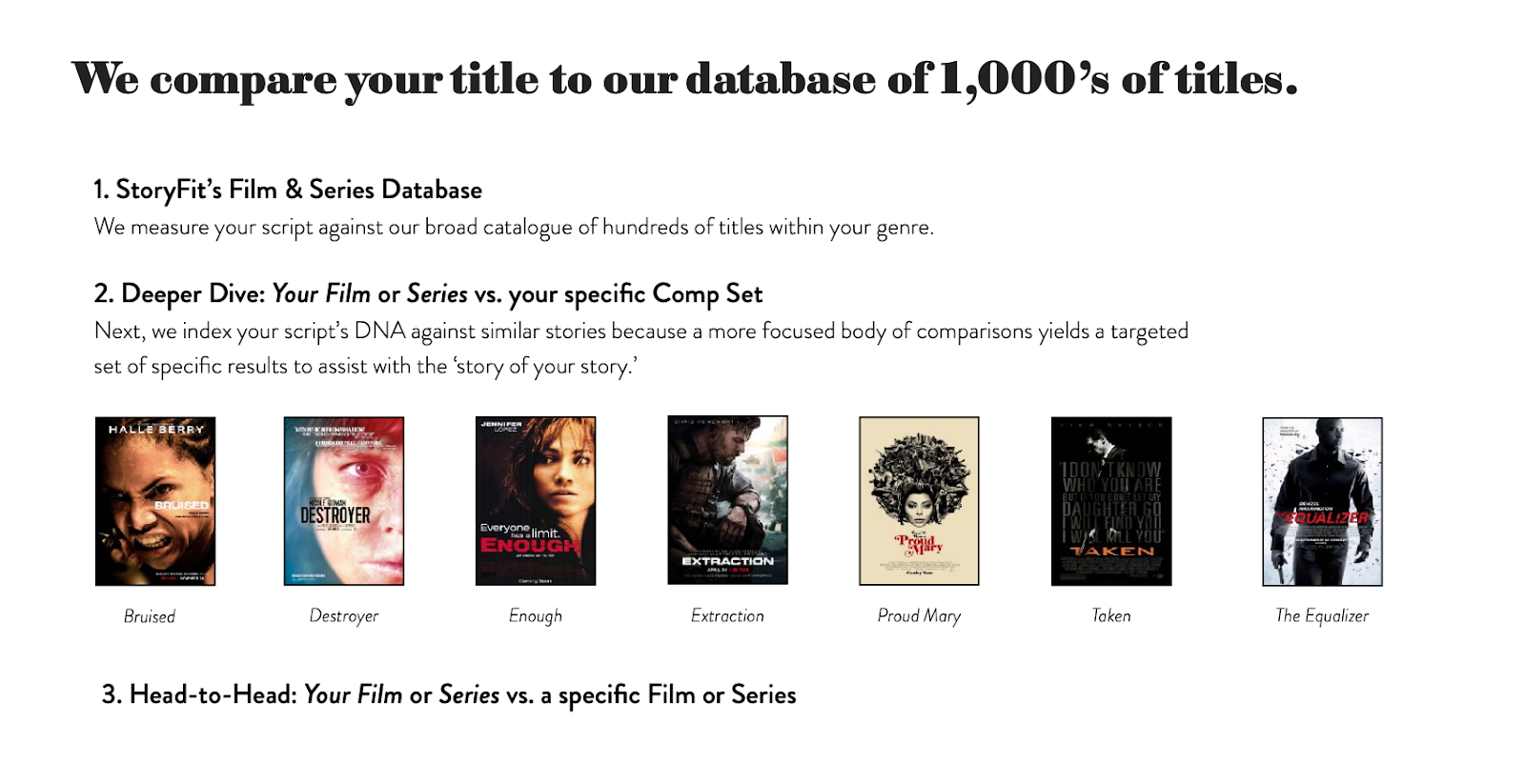
Once the genre is identified, the script is measured against other scripts within StoryFit’s expansive film and series database for that particular genre.
It’s important to see where your story fits against the genre as a whole, helping to answer questions like, “how do I measure up against all Action-Thrillers?”
When making decisions about your story’s potential success, you want those decisions to rely on the most accurate data. This is where your specific comp set comes in.
Applying genre and sub-genre AI models, StoryFit takes a deeper dive into your script, indexing its DNA against the most similar stories, because a more focused body of comparison yields a targeted set of results to assist with the ‘story of your story.’ Where does your story stand out in terms of strength and unique qualities?
Already have a film or series in mind you believe is a great comp and want to see how your script measures up? No problem!
Our platform allows you to compare your title directly to any script, generating tailored insights that deliver data on how your narrative, characters, emotional tones, and predicted audience all rank against your selected title.
By offering three levels of targeted analysis – genre, comps, head-to-head, StoryFit can answer your most pressing questions, working to uncover your script’s strengths, risks, and opportunities for development.
Defining Elements & Themes
In addition to genre, recognizing the key themes and elements that characterize your story are a great way to determine a true comp set for your script.
If your script is a Sci-Fi fantasy, it’s no surprise that the majority of your comps will be within that same genre. However, if there is also a significant love story or romance element between the two leads, it may be just as important to comp against non-Sci-Fi love stories that emphasize a similar love connection that drives the central plot.
Key metrics to consider when evaluating potential comps include character narratives (hero’s journey, story archetypes, protagonist struggles), thematic pitfalls, or emotional pacing.
When we analyze your story against our AI’s identified comp set, our entertainment analytics technology can recognize your script’s superpowers (elements that outperform and dominate when compared to the comp set) and shared story drivers (elements that your story shares with others like it). These elements are then evaluated in correlation to viewership. The higher the correlation, the more likely the element drives audience engagement within the genre.
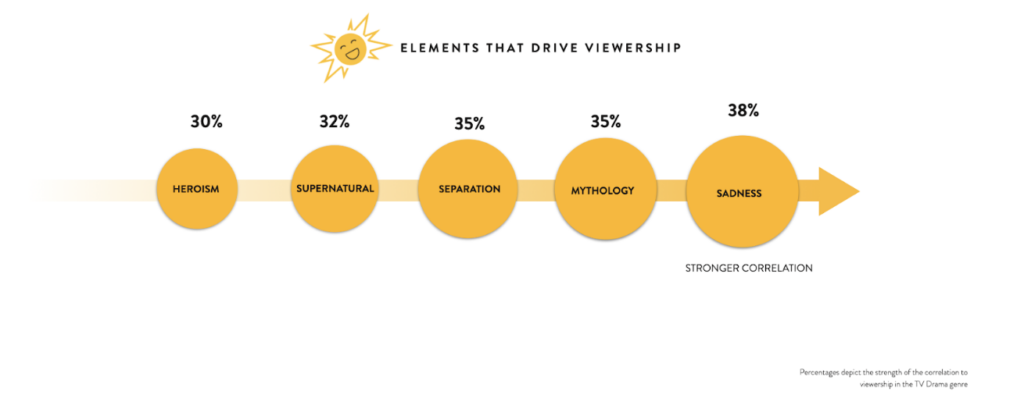
StoryFit evaluates your story’s unique elements or “superpowers” to measure its relative strength in specific characteristics that propel the narrative.
In the chart below, you can see that while Group Rivalry, Mystical, and Fairy Tale are the top three elements that register above the genre average for this Drama-Mystery script, Mystical is the most correlated of the three to viewership in the genre.
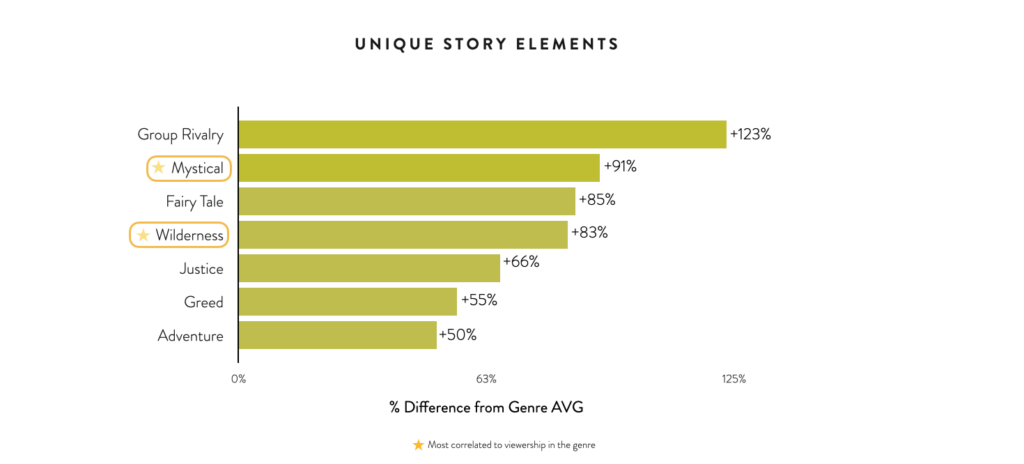
Success is never guaranteed in the entertainment industry – which is why it’s so crucial to identify growing viewership trends among audiences and adapt accordingly.
Recognizing the fluid nature of the media is key to remaining relevant. Staying up-to-date with evolving audience preferences and new genres/sub-genres that emerge will help you produce content that speaks to the present entertainment climate and subsequently drive viewership.
Standout & Supportive Characters
Character comps play just as big of a role in the selection of your script’s comparable titles.
Unlike narrative, character comps can be either dependent, or independent, of genre. Oftentimes character comps diverge in both content type (film & T.V.) and for T.V., running time (60 minutes vs. 30 minutes).
If your lead is a rabble-rousing 60-year old woman, you want her to be compared against other bold protagonists that flaunt their age and do so in style – regardless of the types of stories these characters exist in.
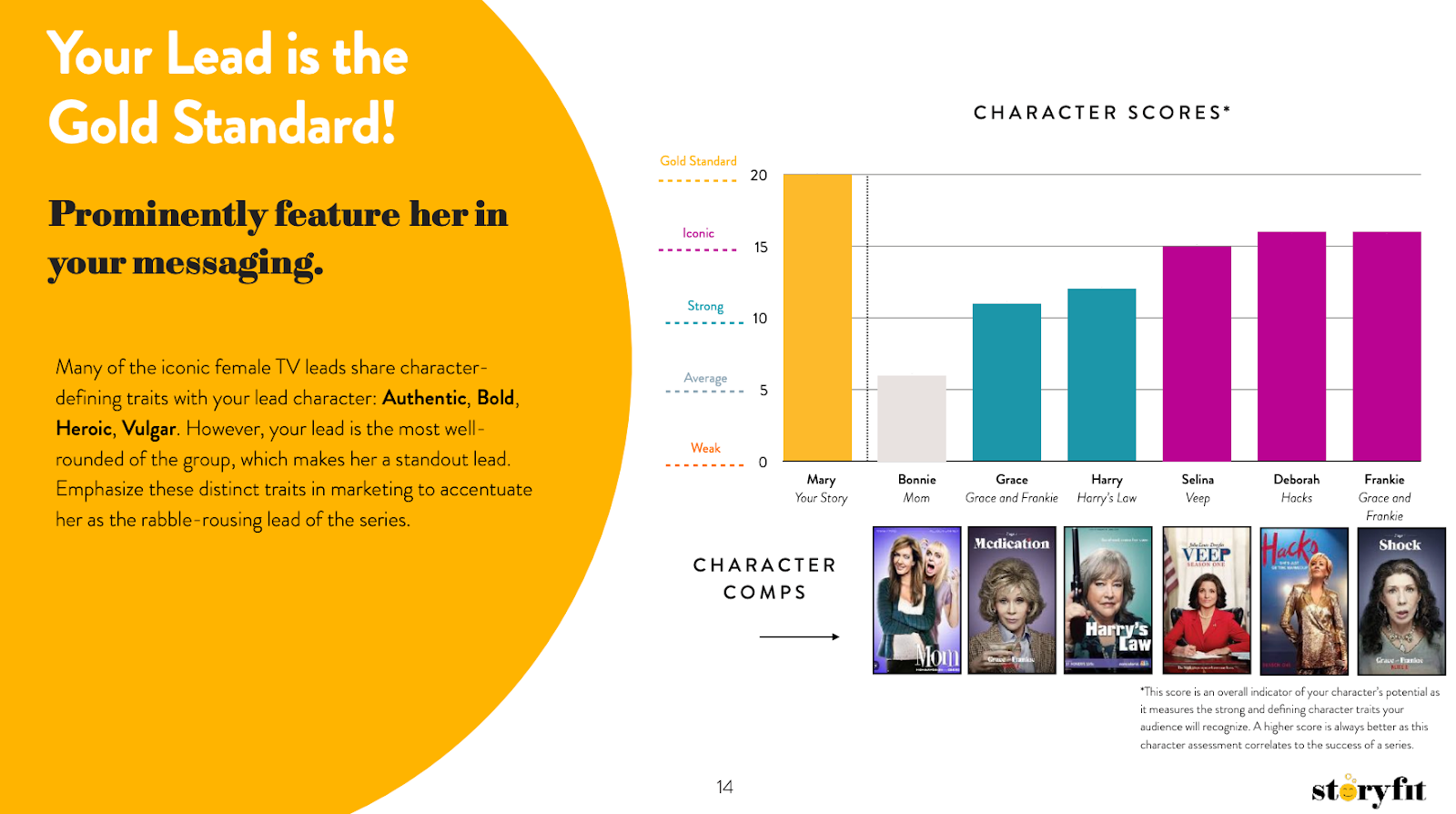
Many of the iconic older female TV leads listed above share the character-defining traits of Authentic, Bold, Heroic, and Vulgar. If your lead shares these qualities, but is the most well-rounded of the group, you would want to emphasize these distinct traits in marketing (similar to how your comps did) to accentuate your character and attract parallel audiences.
Knowing Your Audience
Once you have determined your selected comp titles, you can begin to understand who their audience is and where their interests lie. This will be a crucial factor in evaluating your own target audience demographics.
The kinds of movies and shows your comp audiences enjoy watching can reveal why they might be inclined to watch your story and what their viewing habits are.
Audience affinity is the leading indicator of what is distinctive or unique for your target audience.
More specifically, affinity measures the degree to which a specific audience is interested in something relative to the American general adult population.
StoryFit delivers concise and predictive audience insights to help you evaluate your audience’s viewing interests and determine the likelihood of these viewers also watching your story.
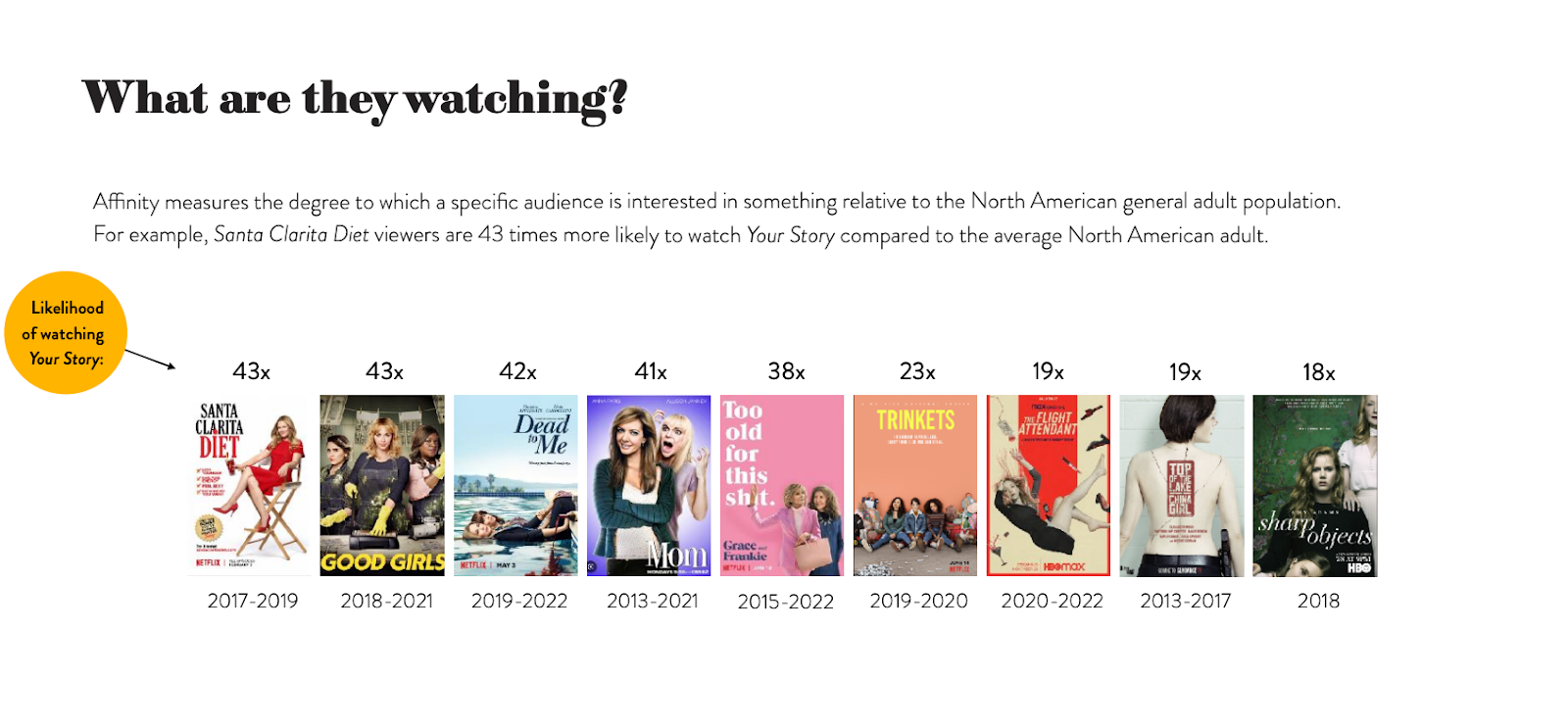
Past Performance Is A Good Indicator of Potential Range
While it may not be the end-all-be-all for predicting success, the past performance of your comp set is a fairly reliable range of the potential ROI for your story.
Although factors like casting, director, time of release, production, and distribution can all impact the success of your film, analyzing your comp’s box office revenue can help you understand the financial potential of your script, identify profitable ventures, and make informed decisions regarding future investments.
Selecting a specific comp set may also aid in how to structure or shape your story’s marketing campaign.
Unlike other comping tools, StoryFit’s story intelligence platform doesn’t just select comp titles that performed the best in the box office.
Our AI engine will provide a personalized performance range to clarify which comps your story is most similar to in terms of shared elements & themes, budget & box office, providing a concise and realistic depiction of your performance potential.
You can then use this information to tailor your film or television marketing and distribution strategy. Highlighting the elements that drive viewership the most will increase your chances of generating a box office success.
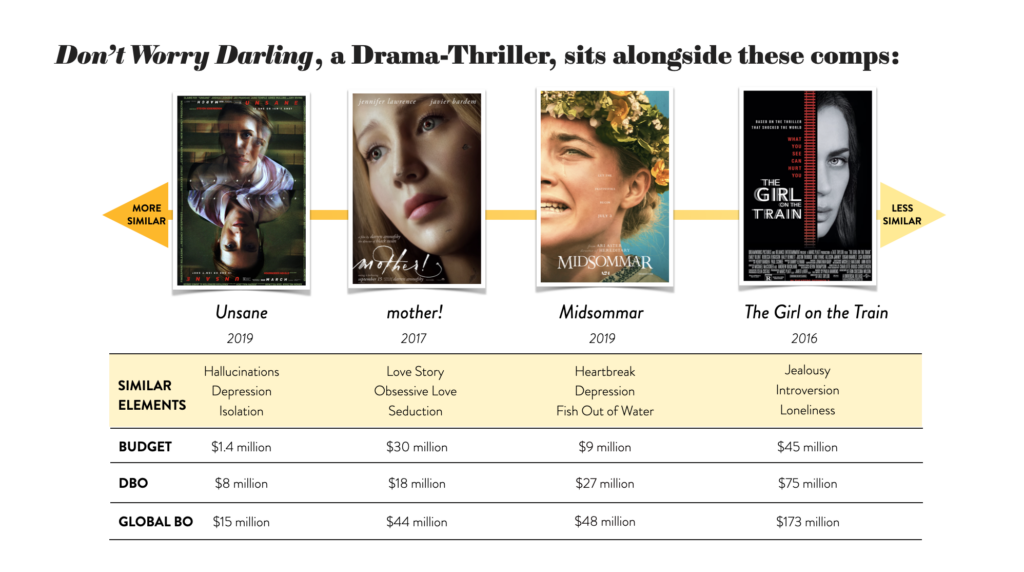
Conclusion
Finding the right comp set for your script is a powerful tool in effectively bringing your story to life.
If you have a thorough understanding of the stories that share characteristics or qualities with your own, you will have a much better plan of how to develop, position, and market your story so it targets the right audience and achieves the best possible performance outcome.
Utilizing script comps can also help you celebrate your own story’s originality. By recognizing what you share with other stories, you can begin to accentuate the themes and elements that make your story stand out from the crowd.
Curious about your script’s unique elements? Want to know who your best-fit comps are?
